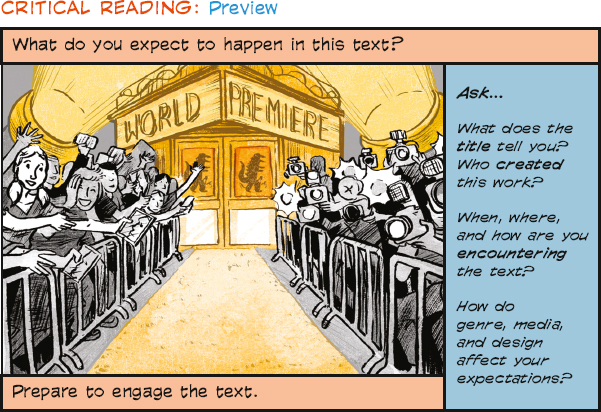12aPreview the text.
Find out all you can about a text before beginning to look closely at it, considering its context, author, subject, genre, and design.
PREVIEWING THE CONTEXT
- Where have you encountered the work? Are you encountering it in its original context? For example, an essay in a collection of readings may have been previously published in a magazine; a speech you watch on YouTube may have been delivered to a live or televised audience; a painting on a museum wall may have been created for a wealthy patron in a distant country centuries earlier.
- What can you infer from the original or current context of the work about its intended audience and purpose?
LEARNING ABOUT THE AUTHOR OR CREATOR
- What information can you find about the author or creator of the text?
- What purpose, expertise, and possible agenda might you expect this person to have? Where do you think the author or creator is coming from in this text?

Go to the Thinking Visually exercise to analyze this image.
PREVIEWING THE SUBJECT
- What do you know about the subject of the text?
- What opinions do you have about the subject, and on what are your opinions based?
- What would you like to learn about the subject?
- What do you expect the main point to be? Why?
CONSIDERING THE TITLE, MEDIUM, GENRE, AND DESIGN
- What does the title (or caption or other heading) indicate?
- What do you know about the medium (or media) in which the work appears? Is it a text on the Web, a printed advertising brochure, a speech stored in iTunes, an animated cartoon on television, or some combination of media? What role does the medium play in achieving the purpose and connecting to the audience?
- What is the genre of the text—and what can it help illuminate about the intended audience or purpose? Why might the authors or creators have chosen this genre?
- How is the text presented? What do you notice about its formatting, use of color, visuals or illustrations, overall design, general appearance, and other design features?
Critical Thinking
TALKING THE TALK
Critical Thinking
“Are criticizing and thinking critically the same thing?” Criticize can sometimes mean “find fault with,” and you certainly don’t have to be relentlessly negative to think critically. Instead, critical thinking means, first and foremost, asking good questions—and not simply accepting what you see at face value. By asking not only what words and images mean, but also how meaning gets across, critical thinkers consider why a text makes a particular claim, what writers may be leaving out or ignoring, and how to tell whether evidence is accurate and believable. If you’re considering questions like these, then you’re thinking critically.
Sample preview of an assigned text
A student in a first-year composition class who had been asked to read and analyze Abraham Lincoln’s Gettysburg Address made preview notes, a few of which are excerpted here.
President Lincoln delivered the speech at a ceremony dedicating a national cemetery for Civil War soldiers. Crowds of people gathered in a field near Gettysburg, Pennsylvania, on November 19, 1863, to listen to him and other speakers. In July of that year, a Civil War battle that ended with 7,500 soldiers killed had taken place near where Lincoln spoke.
My textbook has the most famous version of the speech—but nobody knows for sure exactly what Lincoln said 150 years ago. There’s obviously no audio recording of him giving the speech! Newspapers at the time reported what listeners heard, but he didn’t write the speech out until later.
Lincoln gave this speech in the middle of the war, dedicating a national cemetery, so it must have been a pretty solemn occasion. He probably wanted his audience to think about why the war was worth fighting. He probably also thought that some of the dead soldiers’ families might be there listening—as well as people who had seen the battle or its aftermath. Did he think about the possibility that future generations would read and think about this speech? As the leader of the Union, he was probably very interested in showing why the United States needed to stay together.